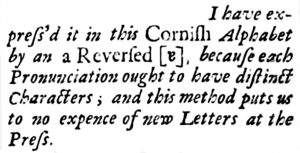Turned A

Turned A (capital: Ɐ, lowercase: ɐ, math symbol ∀) is a letter and symbol based upon the letter A.
Modern usage
[edit]- Lowercase ɐ (in Roman or two story form) is used in the International Phonetic Alphabet to identify the near-open central vowel. This is not to be confused with the turned alpha or turned script a, ɒ, which is used in the IPA for the open back rounded vowel.[1]
- The logical symbol ∀ has the same shape as a sans-serif capital turned A. It is used to represent universal quantification in predicate logic, where it is typically read as "for all". It was first used in this way by Gerhard Gentzen in 1935, by analogy with Giuseppe Peano's turned E notation for existential quantification and the later use of Peano's notation by Bertrand Russell.[2]
Historical usage
[edit]-
Turned a presented in Edward Lhuyd's Archaeologia Britannica, 1707.
-
Turned a in William Pryce's Archaeologia Cornu-Britannica, 1790.
Because of the relative ease of creating this letterform using traditional printing methods, it had frequent and varied historical uses. According to the principle of acrophony, the letter A originated from the Proto-Sinaitic alphabet as a symbol representing the head of an ox or cow (aleph), its orientation and original meaning having been lost over time. The turned A symbol restores the letter to a more easily recognizable logographic representation of an ox's head.[3]
A denarius coin from the Roman Republic has been found, struck with a (capital) turned A, in the collection of a Madrid-based numismatist; it is unclear whether this was intentional, or a printer's error for a V.[4]
It was used in the 18th century by Edward Lhuyd and William Pryce as a phonetic character for the Cornish language. In their books, both Ɐ and ɐ have been used.[5] It was used in the 19th century by Charles Sanders Peirce as a logical symbol for un-American.[6]
U+1D44 ᵄ MODIFIER LETTER SMALL TURNED A is used in the Uralic Phonetic Alphabet,[7] a system developed in the early 20th century for transcribing Uralic languages. However, as this system was not standardized across (nor within) languages, it has been supplanted in this use by the International Phonetic Alphabet.[8]
Encodings
[edit]| Preview | Ɐ | ɐ | ∀ | |||
|---|---|---|---|---|---|---|
| Unicode name | LATIN CAPITAL LETTER TURNED A | LATIN SMALL LETTER TURNED A | FOR ALL | |||
| Encodings | decimal | hex | dec | hex | dec | hex |
| Unicode | 11375 | U+2C6F | 592 | U+0250 | 8704 | U+2200 |
| UTF-8 | 226 177 175 | E2 B1 AF | 201 144 | C9 90 | 226 136 128 | E2 88 80 |
| Numeric character reference | Ɐ |
Ɐ |
ɐ |
ɐ |
∀ |
∀ |
| Named character reference | ∀, ∀ | |||||
| Symbol font | 34 | 22 | ||||
| TeX | \forall | |||||
See also
[edit]References
[edit]- ^ Gibbon, Dafydd; Richard Winski, Roger Moore (1997). "Table A.19: IPA Table (ordered by number) (continued)". Handbook of Standards and Resources for Spoken Language Systems. Walter de Gruyter. p. 679. ISBN 9783110153668.
- ^ Miller, Jeff. "Earliest Uses of Symbols of Set Theory and Logic". Earliest Uses of Various Mathematical Symbols.
- ^ Jensen, Hans (1969). Sign, Symbol, and Script. New York: G.P. Putman's Sons. p. 262. ISBN 9780044000211.
- ^ Debernardi, Pierluigi (2010). "Some unlisted varieties and rare dies in Roman Republican denarii". The Numismatic Chronicle. 170: 93–97. JSTOR 42678886.
- ^ Michael Everson, Proposal to add Latin letters and a Greek symbol to the UCS, ISO/IEC JTC1/SC2/WG2 N3122 L2/06-266 (2006)
- ^ Page 320 in Randall Dipert, "Peirce's deductive logic". In Cheryl Misak, ed. The Cambridge Companion to Peirce. 2004
- ^ Everson, Michael; et al. (2002-03-20). "L2/02-141: Uralic Phonetic Alphabet characters for the UCS" (PDF).
- ^ Simon, Eszter; Mus, Nikolett (January 2017). "Languages under the influence: Building a database of Uralic languages". In Tyers, Francis M.; Rießler, Michael; Pirinen, Tommi A.; Trosterud, Trond (eds.). Proceedings of the Third Workshop on Computational Linguistics for Uralic Languages (PDF). St. Petersburg, Russia: Association for Computational Linguistics. pp. 10–24. doi:10.18653/v1/W17-0603.

